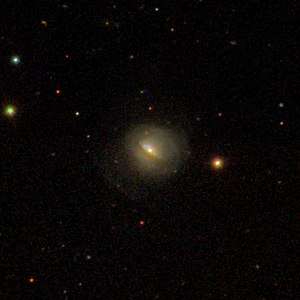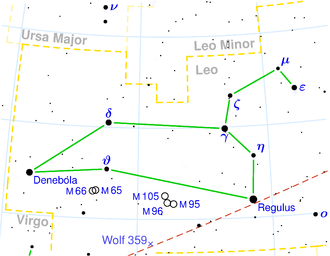IC 2637
| Galaxy IC 2637 |
|
|---|---|

|
|
| SDSS recording | |
| AladinLite | |
| Constellation | lion |
|
Position equinox : J2000.0 , epoch : J2000.0 |
|
| Right ascension | 11 h 13 m 49.7 s |
| declination | + 09 ° 35 ′ 11 ″ |
| Appearance | |
| Morphological type | E + / pec / Sy1.5 |
| Brightness (visual) | 12.9 mag |
| Brightness (B-band) | 13.9 likes |
| Angular expansion | 0.80 x 0.8 |
| Surface brightness | 12.5 mag / arcmin² |
| Physical data | |
| Redshift | 0.029230 ± 0.000083 |
| Radial velocity | 8763 ± 25 km / s |
|
Stroke distance v rad / H 0 |
(387 ± 27) · 10 6 ly (118.7 ± 8.3) Mpc |
| history | |
| discovery | Max Wolf |
| Discovery date | March 27, 1906 |
| Catalog names | |
| IC 2637 • UGC 06259 • PGC 034199 • CGCG 67-36 • MCG + 02-29-011 • IRAS 11112 + 0951 • 2MASX J11134972 + 0935106 • Mrk 732 • GALEX ASC J111349.78 + 093511.3 | |
IC 2637 is an elliptical galaxy with an active nucleus of the Hubble type E0 in the constellation Leo on the ecliptic . It is estimated to be 387 million light years away from the Milky Way and has a diameter of around 90,000 ly.
In the same area of the sky there are u. a. the galaxies IC 676 , IC 2639 , IC 2648 , IC 2676 .
The Type I supernova SN 1989G was observed here.
The object was discovered by Max Wolf on March 27, 1906 .
